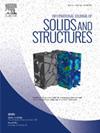Lost in homogenisation: Navigating the challenges of predicting ideal behaviour in inhomogeneous porous structures
IF 3.4
3区 工程技术
Q1 MECHANICS
International Journal of Solids and Structures
Pub Date : 2025-06-11
DOI:10.1016/j.ijsolstr.2025.113522
引用次数: 0
Abstract
We introduce a novel meta-modelling approach coupled with a four-part piecewise constitutive model to predict the compressive behaviour of homogeneous foams using data from inhomogeneous specimens. This method estimates individual density layer responses within the foam, enabling the prediction of compression behaviour for ideal density configurations. Validated through cellulose pulp fibre foam experiments utilising Digital Image Correlation (DIC) analysis and finite element simulations of synthetic expanded polystyrene (EPS) foam, our meta-model effectively derives material properties from imperfect foams of varying densities, while accounting for errors induced by density variations. It accurately captures foam material response from initial compression through densification. Our approach offers significant advantages for optimising foam structures without costly commercial software or ideal specimens, bridging the gap between real-world materials and idealised models. While initially designed for cellulose pulp fibre foams, this model shows broad potential for evaluating various foams with density variations, including both sustainable and non-sustainable materials.
迷失在均质化中:在非均质多孔结构中预测理想行为的挑战
我们引入了一种新的元模型方法,结合四部分分段本构模型,利用非均匀试样的数据预测均匀泡沫的压缩行为。该方法估计泡沫中单个密度层的响应,从而能够预测理想密度配置的压缩行为。利用数字图像相关(DIC)分析和合成膨胀聚苯乙烯(EPS)泡沫的有限元模拟,通过纤维素纸浆纤维泡沫实验验证,我们的元模型有效地从不同密度的不完美泡沫中提取材料特性,同时考虑密度变化引起的误差。它准确地捕捉了泡沫材料从初始压缩到致密化的反应。我们的方法为优化泡沫结构提供了显著的优势,无需昂贵的商业软件或理想样品,弥合了现实世界材料和理想模型之间的差距。虽然最初是为纤维素纸浆纤维泡沫设计的,但该模型显示出广泛的潜力,可以评估各种密度变化的泡沫,包括可持续和非可持续材料。
本文章由计算机程序翻译,如有差异,请以英文原文为准。
求助全文
约1分钟内获得全文
求助全文
来源期刊
CiteScore
6.70
自引率
8.30%
发文量
405
审稿时长
70 days
期刊介绍:
The International Journal of Solids and Structures has as its objective the publication and dissemination of original research in Mechanics of Solids and Structures as a field of Applied Science and Engineering. It fosters thus the exchange of ideas among workers in different parts of the world and also among workers who emphasize different aspects of the foundations and applications of the field.
Standing as it does at the cross-roads of Materials Science, Life Sciences, Mathematics, Physics and Engineering Design, the Mechanics of Solids and Structures is experiencing considerable growth as a result of recent technological advances. The Journal, by providing an international medium of communication, is encouraging this growth and is encompassing all aspects of the field from the more classical problems of structural analysis to mechanics of solids continually interacting with other media and including fracture, flow, wave propagation, heat transfer, thermal effects in solids, optimum design methods, model analysis, structural topology and numerical techniques. Interest extends to both inorganic and organic solids and structures.

 求助内容:
求助内容: 应助结果提醒方式:
应助结果提醒方式:


